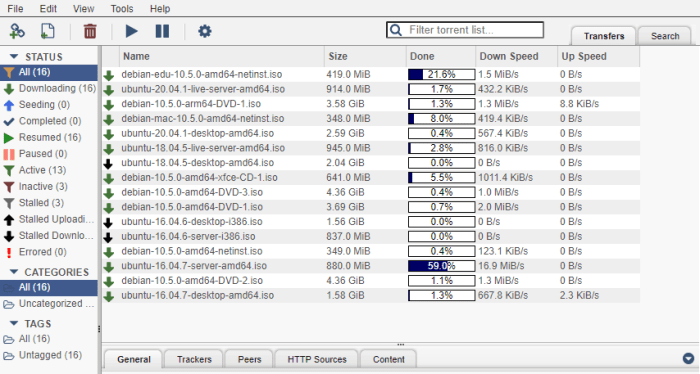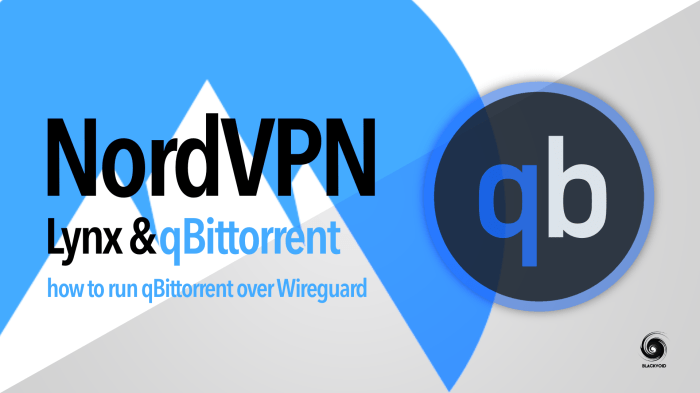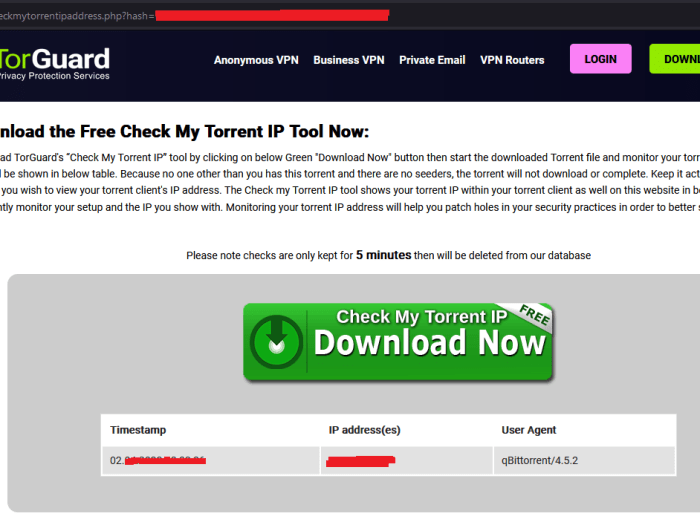In the realm of torrenting, anonymity and privacy are paramount concerns. Enter QBittorrent WireGuard Docker, a powerful solution that combines the strengths of QBittorrent and WireGuard to deliver a secure and private torrenting experience. By harnessing the power of Docker, this setup simplifies deployment and enhances flexibility, making it an ideal choice for torrent enthusiasts.
In this comprehensive guide, we’ll delve into the intricacies of QBittorrent WireGuard Docker, exploring its installation, configuration, performance optimization, security considerations, and advanced customization options. We’ll also compare it to alternative solutions and showcase real-world examples to illustrate its effectiveness.
QBittorrent WireGuard Docker Overview

QBittorrent WireGuard Docker is a containerized solution that combines the powerful torrent client QBittorrent with the advanced VPN technology of WireGuard. This integration provides several advantages for users seeking secure and efficient torrenting.Docker offers a lightweight and isolated environment for deploying applications, making it an ideal platform for QBittorrent and WireGuard.
Docker containers are self-contained and can be easily managed and deployed, ensuring consistency and reproducibility across different systems.
Advantages of Using Docker for QBittorrent with WireGuard
Using Docker for QBittorrent with WireGuard offers several benefits:
-
-*Simplified Deployment
Docker automates the installation and configuration process, making it easier to deploy and manage QBittorrent with WireGuard.
-*Isolation
Docker containers provide isolation, ensuring that QBittorrent and WireGuard run in a separate and secure environment, preventing conflicts with other applications.
-*Resource Management
Docker allows for efficient resource allocation, ensuring that QBittorrent and WireGuard have access to the necessary resources while minimizing system overhead.
-*Portability
Docker containers can be easily moved between different hosts and platforms, providing portability and flexibility for QBittorrent and WireGuard deployments.
Installation and Configuration
Setting up QBittorrent WireGuard Docker involves installing both components and configuring them to work together.
Installing QBittorrent and WireGuard
- Pull the QBittorrent image:
docker pull linuxserver/qbittorrent - Pull the WireGuard image:
docker pull linuxserver/wireguard
Configuring QBittorrent
- Create a volume for QBittorrent data:
docker volume create qbittorrent-data - Run QBittorrent with the volume and WireGuard network:
docker run- d
- -name qbittorrent
- -network wg0
--volume qbittorrent-data
/config linuxserver/qbittorrent
Configuring WireGuard
- Create a WireGuard interface:
wg genkey | tee privatekey | wg pubkey < privatekey > publickey - Create a WireGuard configuration file:
nano wg0.conf - Add the following to the configuration file, replacing
with your server’s IP address: [Interface] Address = 10.10.10.1/24 PrivateKey =
ListenPort = 51820 PostUp = iptables -A FORWARD -i wg0 -j ACCEPT; iptables -t nat -A POSTROUTING -o eth0 -j MASQUERADE PostDown = iptables -D FORWARD -i wg0 -j ACCEPT; iptables -t nat -D POSTROUTING -o eth0 -j MASQUERADE - Run WireGuard with the configuration file:
docker run -d --name wireguard --network host --cap-add=NET_ADMIN -v /path/to/wg0.conf:/etc/wireguard/wg0.conflinuxserver/wireguard
WireGuard Networking
WireGuard is a cutting-edge virtual private network (VPN) protocol that offers unparalleled levels of security, privacy, and performance. It is specifically designed to be lean, efficient, and incredibly fast, making it an ideal choice for use with QBittorrent Docker.
WireGuard employs advanced cryptography and modern network protocols to establish secure and private connections between devices. Its simplicity and efficiency make it easy to set up and maintain, providing a seamless user experience.
Integration with QBittorrent Docker
The integration of WireGuard with QBittorrent Docker brings numerous advantages, including:
- Enhanced privacy and anonymity while torrenting.
- Bypass geo-restrictions and censorship to access content from anywhere in the world.
- Improved download speeds by encrypting traffic and reducing latency.
- Protection against malicious actors and snoopers attempting to intercept or monitor your online activities.
By leveraging the capabilities of WireGuard, QBittorrent Docker users can enjoy a secure, private, and high-performance torrenting experience.
Performance Optimization
Fine-tuning your QBittorrent WireGuard Docker container can enhance its performance and optimize download and upload speeds. Here are some practical tips:
Network Optimization
* Ensure your host machine has a stable and fast internet connection.
- Consider using a wired Ethernet connection instead of Wi-Fi for a more reliable and faster connection.
- If using Wi-Fi, ensure the router is located close to the host machine and there are minimal obstacles between them.
- Adjust your router’s settings to prioritize traffic for your QBittorrent container.
Resource Allocation
* Allocate sufficient CPU and RAM resources to your QBittorrent container.
- Monitor resource usage and adjust the allocation accordingly to avoid performance bottlenecks.
- Use a lightweight Linux distribution as the base image for your container to reduce resource overhead.
Port Forwarding
* Configure port forwarding on your router to direct incoming connections to the QBittorrent container.
- Use a dedicated port for QBittorrent to avoid conflicts with other applications.
- Ensure the port is open on your firewall and is not blocked by your ISP.
Tuning QBittorrent Settings
* Optimize QBittorrent’s connection settings for your network and internet connection.
- Adjust the number of connections, upload slots, and download slots to suit your needs.
- Experiment with different encryption algorithms and protocols to find the best combination for your setup.
Security Considerations
Using QBittorrent WireGuard Docker offers security benefits, but it’s essential to be aware of potential risks and implement appropriate measures to mitigate them.
One potential risk is unauthorized access to the Docker container, which could allow an attacker to gain control over the QBittorrent client and potentially compromise your network. To mitigate this risk, ensure you use strong passwords and implement proper access control mechanisms.
Best Practices
- Use a strong and unique password for the Docker container.
- Limit access to the Docker container to authorized users only.
- Keep the QBittorrent WireGuard Docker image up to date with the latest security patches.
- Monitor the Docker container for suspicious activity and take appropriate action if necessary.
Troubleshooting and Maintenance

Troubleshooting issues with QBittorrent WireGuard Docker can be approached by examining logs, verifying configuration, and inspecting network settings. Regular maintenance involves updating the Docker image, monitoring performance, and reviewing security settings.
Troubleshooting Techniques
* Check Docker logs for errors and warnings.
- Verify that WireGuard settings in QBittorrent and Docker match.
- Ensure that the VPN tunnel is established and functioning correctly.
- Examine network settings to confirm proper routing and firewall rules.
Maintenance Guidelines
* Update the Docker image regularly to receive security fixes and performance improvements.
- Monitor performance metrics like CPU usage, memory consumption, and network speed to identify potential issues.
- Review security settings periodically to ensure compliance with best practices.
Advanced Configuration

QBittorrent WireGuard Docker offers a range of advanced configuration options to customize its behavior and optimize its performance for specific use cases and requirements.
These advanced settings allow users to fine-tune various aspects of the container, including network settings, security parameters, and resource allocation.
Network Settings
- Port Forwarding: Configure port forwarding rules to map external ports to specific ports within the container, enabling access to services running inside the container from outside the host system.
- DNS Configuration: Specify custom DNS servers or use the host’s DNS settings to resolve domain names within the container.
- Network Interface: Choose the network interface to use for the container’s network connectivity, allowing for isolation or integration with specific network segments.
Security Parameters
- WireGuard Configuration: Advanced WireGuard settings can be configured, such as the use of different encryption algorithms, key sizes, and handshake parameters.
- Firewall Rules: Define custom firewall rules to restrict or allow network traffic based on specific criteria, enhancing the security of the container.
- Authentication: Configure authentication methods for the WireGuard tunnel, including the use of certificates or preshared keys.
Resource Allocation
- CPU and Memory Limits: Set limits on the CPU and memory resources that the container can utilize, preventing excessive resource consumption.
- Storage: Configure the storage volume for the container, including its size, mount point, and persistence options.
- Network Bandwidth: Specify network bandwidth limits for the container’s network interface, ensuring optimal performance and resource allocation.
Comparisons with Alternative Solutions
QBittorrent WireGuard Docker offers several advantages over other similar solutions:
- Ease of use: The Docker image provides a pre-configured and ready-to-use environment, simplifying the setup and management of QBittorrent with WireGuard.
- Lightweight and efficient: The Docker image is relatively small and resource-efficient, making it suitable for deployment on resource-constrained systems.
- Flexibility: The Docker image can be customized and extended to meet specific requirements, such as integrating with other services or using custom configurations.
However, there are also some potential drawbacks to consider:
- Limited functionality: The Docker image only includes the essential components of QBittorrent and WireGuard, and may not offer the full range of features available in the standalone versions of these applications.
- Potential security risks: Running QBittorrent and WireGuard in a Docker container may introduce additional security risks, as the container shares the host system’s kernel and resources.
Alternative Solutions
Some alternative solutions to QBittorrent WireGuard Docker include:
- Standalone QBittorrent with WireGuard: This involves installing QBittorrent and WireGuard separately on the host system. It offers more flexibility and customization options, but requires more manual configuration and maintenance.
- Virtualization solutions (e.g., VirtualBox, VMware): These solutions allow you to create isolated virtual environments to run QBittorrent and WireGuard, providing better security and resource isolation.
- Cloud-based solutions (e.g., AWS, Azure): These solutions offer managed services for running QBittorrent and WireGuard, providing scalability, reliability, and ease of use, but may come with additional costs.
The best choice depends on the specific requirements and constraints of your environment. QBittorrent WireGuard Docker is a good option for those seeking a simple, lightweight, and flexible solution, while standalone QBittorrent with WireGuard or virtualization solutions may be more suitable for advanced users or those requiring more customization and security.
Case Studies and Examples
QBittorrent WireGuard Docker has gained widespread adoption due to its versatility and effectiveness. Here are some real-world examples of its successful implementation:
A small business with a remote workforce deployed QBittorrent WireGuard Docker to provide secure and efficient file sharing among employees. The Docker containerization ensured easy deployment and maintenance, while WireGuard’s encrypted VPN tunnel protected data transfers from unauthorized access.
Benefits and Lessons Learned
- Improved file sharing efficiency and collaboration among remote team members.
- Enhanced data security through WireGuard’s robust encryption.
- Simplified deployment and management thanks to Docker’s containerization.
- Reduced IT overhead and maintenance costs.
Future Developments and Trends
QBittorrent WireGuard Docker is poised for continued evolution, driven by technological advancements and user demands. Emerging technologies, such as AI and blockchain, have the potential to enhance the solution’s capabilities and efficiency.
Integration with Artificial Intelligence (AI)
AI can optimize network performance by analyzing traffic patterns and adjusting settings accordingly. It can also enhance security by detecting and mitigating potential threats.
Blockchain Integration
Blockchain technology can provide secure and transparent data management for QBittorrent WireGuard Docker. It can facilitate secure data sharing and collaboration among users.
Performance Enhancements
Ongoing developments focus on improving the overall performance of QBittorrent WireGuard Docker. This includes optimizing network throughput, reducing latency, and minimizing resource consumption.
Enhanced Security Features
Future releases will likely introduce additional security features, such as multi-factor authentication, intrusion detection, and encryption enhancements.
Cross-Platform Compatibility
QBittorrent WireGuard Docker aims to expand its compatibility across multiple platforms, including Windows, macOS, and ARM-based devices. This will make the solution accessible to a wider range of users.
Increased User Friendliness
Efforts are underway to simplify the user interface and make QBittorrent WireGuard Docker more accessible to users of all skill levels. This includes providing intuitive configuration options and comprehensive documentation.
Final Summary
QBittorrent WireGuard Docker emerges as a game-changer in the torrenting landscape, providing a secure, private, and efficient solution for discerning users. Its Docker-based architecture simplifies deployment, while its integration with WireGuard ensures robust protection against eavesdropping and censorship. By following the guidance Artikeld in this guide, you can harness the full potential of QBittorrent WireGuard Docker and elevate your torrenting experience to new heights.
